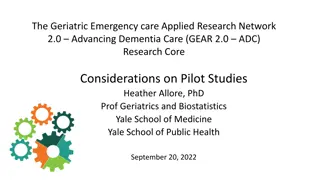Feasibility of Care Coordination for Dual Eligibles: Characteristics and Opportunities
The Pacific Health Policy Group's report discusses the feasibility of care coordination for dual eligibles, individuals eligible for both Medicaid and Medicare with high rates of complex health conditions. Characteristics include having low incomes, chronic physical and mental health conditions, and disproportionate spending in the programs. Medicare is the primary payer, covering most service costs, while Medicaid focuses on long-term care. Opportunities for coordination exist due to the fragmented nature of service delivery for dual eligibles.
Download Presentation

Please find below an Image/Link to download the presentation.
The content on the website is provided AS IS for your information and personal use only. It may not be sold, licensed, or shared on other websites without obtaining consent from the author.If you encounter any issues during the download, it is possible that the publisher has removed the file from their server.
You are allowed to download the files provided on this website for personal or commercial use, subject to the condition that they are used lawfully. All files are the property of their respective owners.
The content on the website is provided AS IS for your information and personal use only. It may not be sold, licensed, or shared on other websites without obtaining consent from the author.
E N D
Presentation Transcript
FEASIBILITY OF CARE COORDINATION FOR DUAL ELIGIBLES THE PACIFIC HEALTH POLICY GROUP DECEMBER 2013
CHARACTERISTICS OF DUAL ELIGIBLES Eligible for both Medicaid and Medicare Disabled and/or age 65 and older, AND Have low incomes and limited financial resources High rates of complex and chronic physical and mental health conditions 67% have a chronic health condition; 31% have three or more conditions 47% percent have a mental health condition; increases to 70% for members with five or more chronic physical conditions Account for disproportionate share of spending in both programs PHPG Care Coordination for Duals 2
CHARACTERISTICS OF DUAL ELIGIBLES contd Share of Medicare and Medicaid Enrollment and Expenditures for Oklahoma s Dual Eligibles Medicare Medicaid Non-Dual 68% 76% 83% 86% Dual 32% 24% 17% 14% Enrollment Expenditures Enrollment Expenditures PHPG Care Coordination for Duals 3
CHARACTERISTICS OF DUAL ELIGIBLES contd Medicare is the primary payer Covers most of the costs of services provided under both programs (e.g., hospital, physician, pharmacy) Medicaid covers mostly long-term care Includes most nursing facility costs and home- and community-based services (HCBS) PHPG Care Coordination for Duals 4
CHARACTERISTICS OF DUAL ELIGIBLES contd Distribution of Medicare and Medicaid Expenditures for Dual Eligibles by Service Type Medicaid ($913M) Medicare ($1,308M) Medicaid & Medicare ($2,221M) Medicaid & Medicare ($2,221M) 3% 1% 5% 4% 4% 7% 3% 16% 14% 25% 40% 16% 7% 4% 7% 7% 8% 21% 25% 8% 42% 16% 11% 15% 8% 9% 21% 8% 13% 11% 21% Inpatient Outpatient Physician Nursing Facility Other Institutional Home Health DME Other PHPG Care Coordination for Duals 5
OPPORTUNITIES FOR COORDINATION AND INTEGRATION Service delivery for dual eligibles is often fragmented Example: Judy has a Medicaid primary care physician; a Medicare primary care physician; receives home health aide services through a Medicaid HCBS waiver; and gets her prescription drugs through a Medicare Part D plan. Medicare and Medicaid are responsible for different services for dual eligibles, but even rules governing similar services vary Example: Short-term skilled nursing facility care under Medicare vs. long-term nursing facility stays under Medicaid PHPG Care Coordination for Duals 6
OPPORTUNITIES FOR COORDINATION AND INTEGRATION cont d Financial incentives to shift costs and lack of incentives to coordinate care Example: Medicaid programs do not stand to reap significant savings from reducing hospitalizations for dual eligibles, as these services are covered mostly by Medicare. The same is true in reverse for Medicare and appropriate utilization of long-term care services. PHPG Care Coordination for Duals 7
HEALTH CARE NEEDS Health care needs of dual eligibles vary Acute and chronic; physical and mental; can be met in the community or require institutionalization Five distinct populations based on need: Nursing facility residents Frail elderly and physically disabled adults who require long-term care HCBS waiver participants Intellectually/developmentally disabled (I/DD) Includes both members receiving care in an intermediate care facility for the intellectually/developmentally disabled (ICF-DD) or through HCBS waiver Other chronically ill members Healthy seniors PHPG Care Coordination for Duals 8
HEALTH CARE NEEDS contd Distribution of Medicaid and Medicare Expenditures for Dual Eligibles by Population Medicaid ($913M) Medicare ($1,308M) Medicaid & Medicare ($2,221M) Medicaid & Medicare ($2,221M) 1% 20% 9% 6% 16% 31% 10% 14% 52% 6% 43% 31% 17% 60% 15% 43% 5% 1% 15% 5% Nursing Facility ADvantage Waiver (HCBS) DDSD Waiver (I/DD) Other Chronically Ill Healthy Seniors PHPG Care Coordination for Duals 9
HEALTH CARE NEEDS contd Distribution of Medicaid and Medicare Expenditures for Dual Eligibles: Nursing Facility Residents Medicaid ($473M) Medicare ($211M) Medicaid & Medicare ($684M) 1% Medicaid & Medicare ($2,221M) 9% 2% 4%2%1% 1%1% 1% 4% 4% 13% 14% 13% 13% 5% 39% 4% 8% 7% 25% 16% 14% 80% 8% 13% 58% 8% 11% 21% Inpatient Outpatient Physician Nursing Facility Other Institutional Home Health DME Other PHPG Care Coordination for Duals 10
HEALTH CARE NEEDS contd Distribution of Medicaid and Medicare Expenditures for Dual Eligibles: ADvantage HCBS Waiver Participants Medicaid ($156M) Medicare ($185M) Medicaid & Medicare ($341M) Medicaid & Medicare ($2,221M) 14% 1% 1% 5% 4% 15% 6% 24% 33% 39% 6% 7% 4% 7% 7% 8% 25% 16% 44% 28% 11% 10% 16% 8% 8% 5% 12% 4% 11% 21% Inpatient Outpatient Physician Nursing Facility Other Institutional Home Health DME Other PHPG Care Coordination for Duals 11
HEALTH CARE NEEDS contd Distribution of Medicaid and Medicare Expenditures for Dual Eligibles: I/DD Population Medicaid ($94.4M) Medicare ($16.5M) Medicaid & Medicare ($111M) Medicaid & Medicare ($2,221M) 13% <1% 1%<1% <1% 2%4% 1% 5% 7% 14% 3% 25% 30% 12% 4% 46% 4% 2% 7% 25% 1% 16% 17% 8% 54% 8% 12% 47% 11% 21% Inpatient Outpatient Physician Nursing Facility Other Institutional Home Health DME Other PHPG Care Coordination for Duals 12
HEALTH CARE NEEDS contd Distribution of Medicaid and Medicare Expenditures for Dual Eligibles: Other Chronically Ill Members Medicaid ($179M) Medicare ($775M) Medicaid & Medicare ($954M) Medicaid & Medicare ($2,221M) 14% 4% 5% 4% 8% 6% 32% 34% 40% 19% 14% 4% 6% 1% 7% 7% 25% 5% 16% 16% <1% 6% 11% 8% 3% 8% 37% 15% 13% 11% 21% Inpatient Outpatient Physician Nursing Facility Other Institutional Home Health DME Other PHPG Care Coordination for Duals 13
HEALTH CARE NEEDS contd Distribution of Medicaid and Medicare Expenditures for Dual Eligibles: Healthy Seniors Medicaid ($10.6M) Medicare ($120M) Medicaid & Medicare ($131M) Medicaid & Medicare ($2,221M) 10% 1% 4% 3% 4% 7% 12% 15% 36% 39% 41% 11% 4% 10% 9% 7% 7% 25% 7% 16% 15% 8% 13% <1% 8% 24% 15% 14% 11% 21% 3% Inpatient Outpatient Physician Nursing Facility Other Institutional Home Health DME Other PHPG Care Coordination for Duals 14
HEALTH CARE NEEDS contd Distribution of Medicaid and Medicare Expenditures for Dual Eligibles: Summary of Populations Expenditures (in millions) ADvantage Waiver (HCBS) DDSD Waiver (I/DD) Other Chronically Ill Program Nursing Facility Healthy Seniors All Dual Eligibles Medicaid $473 $156 $94.4 $179 $10.6 $913 % of Pop. Total 69% 46% 85% 19% 8% 41% Medicare $211 $185 $16.5 $775 $120 $1,308 % of Pop. Total 31% 54% 15% 81% 92% 59% Total $684 $341 $111 $954 $131 $2,221 PHPG Care Coordination for Duals 15
CARE COORDINATION IN OKLAHOMA Existing Programs SoonerCare currently has programs for members with chronic conditions (both duals and non-duals) similar to those offered by private MCOs, for example: Program Type SoonerCare Program Program Highlights Care coordination provided by third party contractor Health Coaches assist members to navigate system and develop self- management skills Practice Facilitators work with providers with a high burden of high-needs patients to improve care delivery and improve outcomes Chronic Disease Management Health Management Program (HMP) State coordinators target members with high costs/needs to ensure enrollment in available SoonerCare programs and assist with coordinating out- of-state care, bilingual services, arrange referrals, and conduct in-home assessments Program targets both medical and behavioral health needs, including coordination of efforts for members with medical/behavioral co-morbidities High-Cost/High- Need Management Population Care Management (PCM) Provides care management, therapies, home health, personal care and other services and supports to help elderly and/or disabled members remain in the community and out of nursing facilities HCBS ADvantage Wavier PHPG Care Coordination for Duals 16
CARE COORDINATION IN OKLAHOMA contd Planned Initiatives Oklahoma is developing multiple care coordination models for dual eligibles through the federal demonstration grant opportunities to integrate care and align financing between Medicare and Medicaid States have two broad options: Managed fee-for-service (MFFS) Capitated To address financial disincentives to coordinate care, CMS will share demonstrated Medicare savings with states Oklahoma is pursuing several models: MFFS - Health Homes MFFS SoonerCare Silver Capitated Integrated Care Sites (ICS) PHPG Care Coordination for Duals 17
CARE COORDINATION IN OKLAHOMA contd Planned Initiatives Health Homes MFFS Partnership between SMHA and DMHSAS for management of members with mental health needs Nurse care manager coordinates care with a team of providers, including community mental health center staff Enhanced 90 percent federal matching rate available SoonerCare Silver MFFS Care coordinator will serve as bridge between Medicare and Medicaid programs and providers Interdisciplinary care team will develop and implement a member-specific care plan PHPG Care Coordination for Duals 18
CARE COORDINATION IN OKLAHOMA contd Planned Initiatives Integrated Care Sites (ICS) Capitated Member receives care at single site, overseen by an interdisciplinary care team, including member, physician, nurse, and social worker Provider receives blended capitation rate from Medicare and Medicaid Flexibility for provider to provide services not covered by Medicare or Medicaid, including nurse practitioner services Member does not have to require nursing facility level of care, but must have two or more complex and chronic conditions, including functional limitations PHPG Care Coordination for Duals 19
MEDICARE MANAGED CARE IN OKLAHOMA Background Medicare Part C program created in 1997; became known as Medicare Advantage (MA) in 2003 Under Part C, Medicare recipients can voluntarily enroll in an MA plan with a private MCO for their Medicare benefits, if available National enrollment in MA plans increased 10% in the past year, up 30% in the past three years Three types of plans: closed network MCO (also known as health maintenance organization [HMO]), preferred provider organization (PPO), and private fee-for-service (PPFS) PHPG Care Coordination for Duals 20
MEDICARE MANAGED CARE IN OKLAHOMA cont d Background Special Needs Plans (SNPs) MA plans open only to certain types of Medicare recipients Dual eligibles D-SNP May include only small subset of Medicaid services FIDE-SNP Created by Affordable Care Act (ACA); integrates delivery and financing of most Medicaid services, including long-term care; only available in seven states Certain chronic conditions (C-SNP) Institutionalized recipients (I-SNP) PHPG Care Coordination for Duals 21
MEDICARE MANAGED CARE IN OKLAHOMA cont d Background Special Needs Plans (SNPs)cont d Most popular is regular D-SNP Medicare Payment Advisory Committee (MedPAC) advised Congress in March 2013 to permanently reauthorize FIDE-SNPs and I-SNPs and let authorization expire for all other SNPS, excluding some C-SNPs (those for enrollees with HIV/AIDS, ESRD, chronic/disabling mental condition) National Oklahoma SNP Number of States Number of SNPs Total Number of SNPs Total Enrollment Enrollment Institutional (I-SNP) 30 68 49,178 1 141 Chronic (C-SNP) 36 214 245,501 0 0 Dual Eligible (D-/FIDE-SNP) 43 362 1,311,679 0 0 Total 46 644 1,606,358 1 141 PHPG Care Coordination for Duals 22
MEDICARE MANAGED CARE IN OKLAHOMA cont d Oklahoma Market Nationally, 29% of Medicare recipients are enrolled in an MA plan; only 16% in Oklahoma. 12 MCOs (nine national, three local) currently have MA enrollees in Oklahoma, though none have enrollment statewide MA Enrollees Total Medicare Recipients MCOs with MA Enrollees SNP Total Urban Mixed Rural Tulsa 119,071 9 32,686 28,382 3,561 743 Oklahoma City 131,083 8 26,372 23,836 0 2,536 East 152,904 9 15,262 0 0 15,262 Northwest 130,249 6 15,019 0 9,194 5,825 Southwest 92,987 4 11,244 6,610 546 4,088 Total 625,594 12 100,583 58,828 13,301 28,454 PHPG Care Coordination for Duals 23
MEDICARE MANAGED CARE IN OKLAHOMA cont d Oklahoma Market cont d Service Area MCO Avg. Market Share Overall Market Share MA Enrollees (counties with MA enrollees) (high to low enrollment) Total Urban Mixed Rural Total Urban Mixed Rural UnitedHealth Community Care Humana Universal Aetna Ardent CIGNA Cherokee Nation Highmark OKC Clinic BCBS WellPoint 38 6 73 23 25 8 7 1 3 1 2 1 3 1 4 4 4 2 0 0 2 1 2 1 5 2 5 4 3 1 0 0 0 0 0 0 30 3 64 15 18 5 7 1 1 0 0 0 41.1% 66.5% 23.0% 7.7% 2.1% 2.3% 26.0% 13.4% 0.1% 0.1% 0.1% 0.1% 37.7% 28.3% 23.0% 6.4% 1.8% 1.5% 1.1% 0.1% 0.0% 0.0% 0.0% 0.0% 37,924 28,439 23,143 6,397 1,829 1,472 1,152 94 41 40 38 14 100,583 25,793 19,312 7,223 4,282 1,305 793 0 0 28 40 38 14 58,828 5,601 5,133 1,737 425 152 253 0 0 0 0 0 0 13,301 6,530 3,994 14,183 1,690 372 426 1,152 94 13 0 0 0 28,454 Total MA Enrollees 625,594 253,370 36,664 335,560 Total Medicare Recipients 16.1% 23.2% 36.3% 8.5% MA Penetration Rate PHPG Care Coordination for Duals 24
MEDICARE MANAGED CARE IN OKLAHOMA cont d Oklahoma Marketcont d Closed network MCO plans are dominant in urban areas (Tulsa, OKC), where 24% of Medicare recipients are enrolled in an MA plan PPO plans consistently enroll approximately 4,000 to 6,000 across all regions Enrollees in PFFS plans live almost exclusively in rural areas MA Enrollees Closed Network MCO 27,613 Total Medicare Recipients MCOs with MA Enrollees MA SNP % MA Enrollees per MCO PPO (all local) Total PFFS 32,686 4,738 335 27.5% 3,632 Tulsa 119,071 9 26,372 21,376 4,815 181 20.1% 3,297 Oklahoma City 131,083 8 15,262 5,717 6,142 3,403 10.0% 1,696 East 152,904 9 15,019 9,373 4,028 1,618 11.5% 2,503 Northwest 130,249 6 11,244 5,143 4,019 2,082 12.2% 2,811 Southwest 92,987 4 100,583 69,222 23,742 7,619 16.1% 8,382 Total 625,594 12 PHPG Care Coordination for Duals 25
MEDICARE MANAGED CARE IN OKLAHOMA cont d Oklahoma Marketcont d Rates Rates paid to MA plans are calculated based on the experience of Medicare recipients enrolled in traditional (i.e., fee-for- service), or benchmarks Include a competitive bid component Risk adjusted based on acuity Based on risk scores, plans could receive around 50% higher payments per dual eligible compared to non-duals Based on recently published benchmarks, urban Medicare recipients in Oklahoma can be slightly higher cost ($814) on the whole than rural recipients ($794); though recipients in mixed counties are higher cost ($850) than urban recipients PHPG Care Coordination for Duals 26
MEDICARE MANAGED CARE IN OKLAHOMA cont d Oklahoma Marketcont d Benefits Vary from plan to plan, county to county In general closed network MCOs have lower monthly premiums than PPOs, but have more restrictive requirements relating to provider networks and referrals Value-added benefits offered by plans not available in traditional Medicare include preventive dental services (e.g., annual cleanings) or vision-related benefits (e.g., glasses). PHPG Care Coordination for Duals 27
MEDICARE MANAGED CARE IN OKLAHOMA cont d Oklahoma Marketcont d Provider Networks MA plans are subject to federal provider network adequacy requirements, e.g., minimum number of providers/facilities and maximum travel time/distance Most national plans in Oklahoma have agreements with a number of several Centers of Excellence (COEs), as summarized below: Community Care Aetna BCBS CIGNA Highmark Humana United Universal 8 8 6 6 1 6 8 1 Note: Four MA MCOs do not have any agreements with COEs: Ardent, Cherokee Nation, OKC Clinic, Wellpoint PHPG Care Coordination for Duals 28
MEDICARE MANAGED CARE IN OKLAHOMA cont d Oklahoma Marketcont d MCOs with MA plans in Oklahoma are participating in care coordination initiatives in other states Federal duals alignment demonstrations SNPs Chronic care management Medicaid managed long-term care PHPG Care Coordination for Duals 29
OTHER STATES MODELS Historically, Medicaid managed care models have excluded dual eligibles Medicare and Medicaid share payment responsibility MCO experience with providing long-term care is limited compared to acute care experience National trends Federal demonstrations to integrate service delivery and financing for dual eligibles between Medicare and Medicaid Many states are enrolling dual eligibles in managed care (usually but exclusively through MCOs) Many states also are beginning to enroll LTC recipients PHPG Care Coordination for Duals 30
OTHER STATES MODELS contd Federal Duals Alignment Demonstrations Three-year demonstration CMS will share demonstrated Medicare savings with states Originally 39 states were interested in pursuing a demonstration; however, only eight states demonstrations currently are approved PHPG Care Coordination for Duals 31
OTHER STATES MODELS contd Federal Duals Alignment Demonstrations cont d Most states pursuing capitated models with MCOs Most have chosen to implement statewide Most states have carved-out and/or delayed implementation for the I/DD population (e.g., New Mexico) Implementation has taken two to three years Percent savings increase over the three-year demonstration period, generally increasing from 1% in the first year to 4%-5% in year three Some states are requiring MCOs to engage with community and specialized providers to ensure access to care (e.g., CA, MA, OH) PHPG Care Coordination for Duals 32
OTHER STATES MODELS contd Federal Duals Alignment Demonstrations cont d Managed fee-for-service (MFFS) Primary model being pursued by Oklahoma Washington is only state with approved demonstration pursuing MFFS model, using health home model Can be used in conjunction with federal Health Home initiative to reduce state costs for care coordination services/start up Coordination services can be provided by state staff, providers, or third party contractor Seeks to adopt managed care principles while building on existing programs and/or community-based infrastructure PHPG Care Coordination for Duals 33
OTHER STATES MODELS contd Managed Care for Duals 24 states enroll duals in Medicaid managed care 39 states have duals enrolled in D-SNPs 21 states contract with Medicare SNPs 7 states offer FIDE-SNPs States have encouraged enrollment by requiring MA plans to offer SNPs in each county they serve States have required plans to engage with community and specialized providers in specific ways to ensure access to care (e.g., CA, MA, OH) PHPG Care Coordination for Duals 34
OTHER STATES MODELS contd Managed Long-Term Care Only 8 states had MLTC programs 10 years ago; 16 states have such programs today; and that number is expected to grow to 26 by 2014 State contracts with MCO to coordinate and provide, at a minimum, long-term care services to Medicaid beneficiaries Capitated payments to MCOs can include: Only Medicaid long-term care services All Medicaid services, including long-term care All Medicare and Medicaid services PHPG Care Coordination for Duals 35
OTHER STATES MODELS contd Managed Long-Term Care cont d Out of the 16 states with MLTC programs: Most states: Enroll both aged and disabled beneficiaries (12) Do not include the I/DD population (10) Do not fully integrate with Medicare (11) Two states require Medicaid plains to offer D-SNPs and coordinate with Medicare; four states require coordination only; and four states have no requirements States are split on: Requiring enrollees to need institutional level of care Making enrollment mandatory vs. voluntary Implementing program statewide vs. only certain region(s) Including all Medicaid services or excluding major service types PHPG Care Coordination for Duals 36
Medicaid Managed Long-Term Care Programs State Aged Disabled I/DD Medicare Integration Institutional LOC Required Enrollment Region Medicaid Services AZ Full Mandatory Statewide All CA Full Voluntary Regional All DE None Mandatory Regional Some Nearly statewide FL Coordination only Voluntary All HI D-SNP + coordination Voluntary Regional Some Nearly statewide MA Full Voluntary All MI None Mandatory Statewide Some MN Full Other Statewide All NC None Mandatory Regional Some NM Coordination only Mandatory Statewide Some NY Full Voluntary Regional All PA None Voluntary Regional Some TN Coordination only Mandatory Statewide Some TX D-SNP + coordination Mandatory Regional Some Nearly statewide WI Full Voluntary All Voluntary (opt-out) WA Coordination only Regional Some PHPG Care Coordination for Duals 37
OPTIONS/Considerations Two key decision points: 1. What populations, i.e., enrollment groups, should be targeted? 2. Under what model should care coordination be implemented? PHPG Care Coordination for Duals 38
OPTIONS/RECOMMENDATIONS contd Enrollment Groups LTC Responsible for most of Medicaid s spending on dual eligibles, therefore greatest opportunity for fiscal impact Approximately10% of population is Medicaid-only I/DD Service needs often non-medical Services often provided by small, non-profit providers MCOs lack expertise providing these services Only small number of states have elected to include this population; some states have taken middle road by enrolling this population in MCOs for acute care services only Approximately 37% of I/DD population is Medicaid-only May be beneficial to enroll last, if included PHPG Care Coordination for Duals 39
OPTIONS/RECOMMENDATIONS contd Enrollment Groupscont d Other (chronically ill and healthy seniors) Majority of dual eligibles Every state that has enrolled the LTC population has enrolled this population opportunity to forestall needs for LTC Do not have to be served under same model Should emphasize integration, as most Medicaid payments are for cost sharing, transportation, and mental health PHPG Care Coordination for Duals 40
OPTIONS/RECOMMENDATIONS contd Potential Models Option 1: Implement MCO/Capitated Model Most states have elected this option, both for LTC and acute- only populations Leverage expertise of national organizations Evidence-based practices Well-defined care management systems Plans have exited markets if profitability targets are not met PHPG Care Coordination for Duals 41
OPTIONS/RECOMMENDATIONS contd Potential Models cont d Option 1: Implement MCO/Capitated Model cont d Platform for integration of Medicare and Medicaid Can encourage or require plans to have MA contracts members can enroll in the same plan for both Medicare and Medicaid benefits Option will require new federal authority (up to 12 months), and plans will need advance notice from the State, as plans can only submit applications to become MA plans in a given county once per year ? Potential changes at federal level should be considered, e.g., potential expiration of SNP authorization Fiscal/budget predictability PHPG Care Coordination for Duals 42
OPTIONS/RECOMMENDATIONS contd Potential Models cont d Option 1: Implement MCO/Capitated Model cont d Fiscal/budget predictability State can better predict and limit its expenditures by placing MCOs at risk Funding must cover MCOs administrative expenses and profits (average of 11.6% in recent survey, compared to 5.5% for Oklahoma Medicaid) ? Other considerations: In first year, State will be paying capitation and claims run out, therefore increasing payments in the short-term Savings from MCOs should not be demanded during the first two years to give MCOs the opportunity to achieve savings through rebalancing, which will occur over the first 24 to 36 months (encourage with financial incentives) Artificially low capitation rates in year one and/or two will cause reduction in services to members and/or payments to providers PHPG Care Coordination for Duals 43
OPTIONS/RECOMMENDATIONS contd Potential Models cont d Option 2: Expand Existing Community-Based Programs and Infrastructure Can be achieved through expansion of the initiatives already underway Example: Under SoonerCare Silver, State could replicate PACE/ICS in additional locations and in conjunction with care management from OHCA Direct contracts with provider and care management organizations under MFFS, risk-sharing, or full risk arrangements PHPG Care Coordination for Duals 44
OPTIONS/RECOMMENDATIONS contd Potential Modelscont d Option 2: Expand Existing Community-Based Programs and Infrastructure cont d Advantages: Lower administrative expenses State retains savings for reinvestment or reduction of general fund needs More provider choice Faster program expansion, especially in rural areas Greater potential for targeting high-cost members Greater flexibility to implement and replicate successful innovations PHPG Care Coordination for Duals 45
OPTIONS/RECOMMENDATIONS contd Potential Models cont d Option 2: Expand Existing Community-Based Programs and Infrastructure cont d Disadvantages: Less spending certainty disadvantage could dissipate over time, depending on MCO demands for rate increases should profits not meet expectations Full integration with Medicare is more difficult disadvantage could be overcome through alternative model where State receives capitation payments from CMS for all Medicare/Medicaid services (e.g., as proposed by Vermont) PHPG Care Coordination for Duals 46
OPTIONS/RECOMMENDATIONS contd Other Considerations Mixed model Oklahoma is not limited to choosing one approach to the exclusion of the other Can vary approach by population Establish realistic timeframes Steps can include: legislation, waiver submission/negotiation, procurement (if using MCOs), and readiness activities Florida: legislation passage to enrollment start 27 months Kansas: program design to enrollment start 24 months New Mexico: program design to enrollment start 33 months PHPG Care Coordination for Duals 47
OPTIONS/RECOMMENDATIONS contd Other Considerations cont d Emphasize person-centered care management Comprehensive assessments of need (regardless of payer) Rigorous care planning and monitoring of services Reduce fragmentation of care, including through establishment of single system for: dual eligibles and LTC (including Medicaid-only LTC) Define appropriate role for doctors (center of care team) Create opportunities for nursing facilities Converting bed space to new uses: respite, adult day Offering financial incentives for identification and transition of residents back to the community (share in savings) PHPG Care Coordination for Duals 48
OPTIONS/RECOMMENDATIONS contd Potential Savings Average utilization/expenditures for CY 2011 and 2012 were trended forward by population for the five-year period 2015 to 2019 Assumed nursing facility bed capacity would grow in proportion to program enrollment PHPG developed high and low scenarios Low LTC system would rebalance from current level to 60% HCBS; overall utilization/expenditures would be reduced by 10% due to service delivery reform High LTC system would rebalance to levels since in the Arizona program, i.e., 70 % HCBS:;overall utilization/expenditures would be reduced by 10% due to service delivery reform PHPG Care Coordination for Duals 49
OPTIONS/RECOMMENDATIONS contd Potential Savingscont d Savings due to rebalancing are achieved over the long term Potential Savings due to "Rebalancing of LTC System in Oklahoma $1,800 Millions $1,600 $1,400 Baseline (51/49) High Scenario 70/30 Low Scenario 60/40 $1,200 $1,000 $800 $600 2015 2016 2017 2018 2019 2020 2021 2022 2023 2024 PHPG Care Coordination for Duals 50























